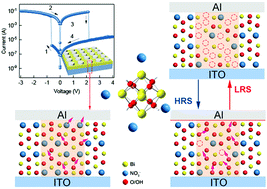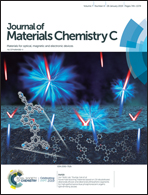A solution processed metal–oxo cluster for rewritable resistive memory devices†
Abstract
Understanding the mobility and electrochemical process of ion species at the nanoscale is the key step to obtain high performance non-volatile data storage devices. Here, we present a systematic study on the resistive switching mechanism of an assembled metal–oxo cluster [Bi6O4(OH)4](NO3)6 (BiON) to build reliable non-volatile memory devices. The bipolar resistive-switching with low operation voltage is observed and is attributed to the migration of ion species (mainly OH−) with low activation energy (∼0.20 eV) along the polar electric field and simultaneous valence change of the bismuth of the [Bi6O4(OH)4] clusters in the BiON film. The X-ray photoelectron spectroscopy (XPS), conductive atomic force microscopy (CAFM) and Kelvin probe force microscopy (KPFM) characterization confirms that OH− with low activation energy is expected to facilitate the formation and rupture of anion vacancy filaments. Moreover, intermediate oxide layers formed at the Al/BiON interfaces could help to stabilize and assist the resistive switching. The control of the clusters and counter-ion species in the metal–oxo cluster-assembled materials represents a step toward next generation multi-level, high-speed and low energy consumption non-volatile memory devices for in-memory computing and artificial intelligence.



 Please wait while we load your content...
Please wait while we load your content...